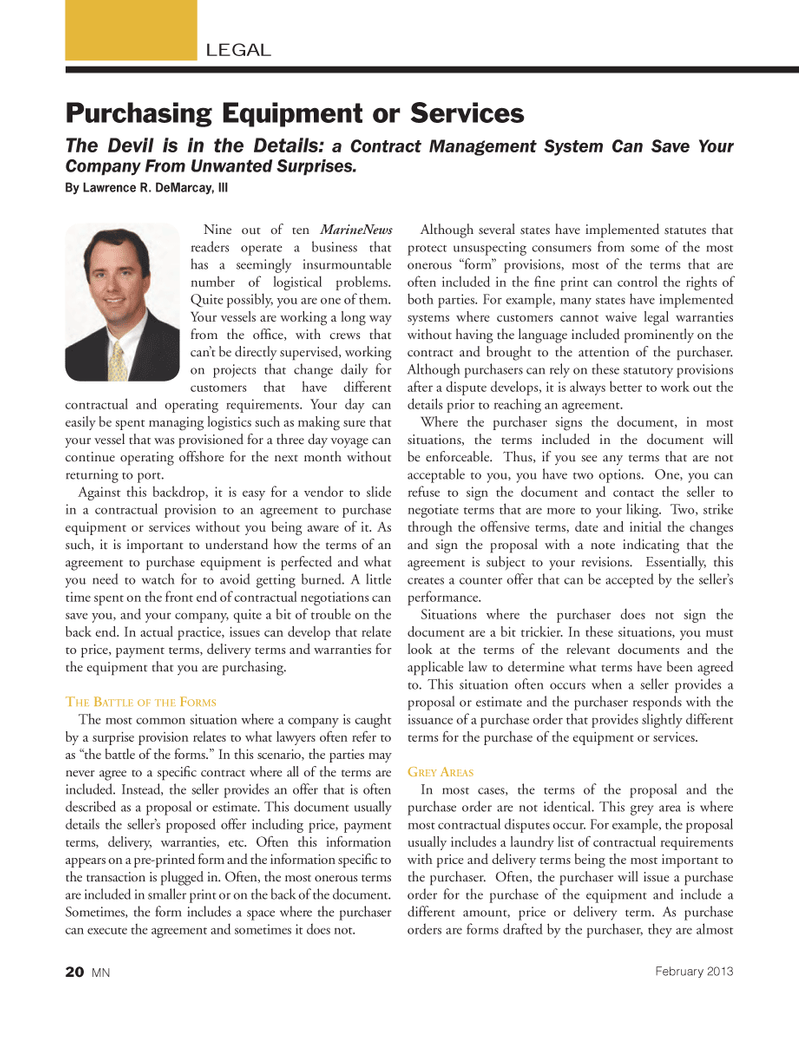
Page 20: of Marine News Magazine (February 2013)
Bulk Transport Leadership Roundtable
Read this page in Pdf, Flash or Html5 edition of February 2013 Marine News Magazine
Nine out of ten MarineNews readers operate a business that has a seemingly insurmountable number of logistical problems. Quite possibly, you are one of them. Your vessels are working a long way from the ofÞ ce, with crews that canÕt be directly supervised, working on projects that change daily for customers that have different contractual and operating requirements. Your day can easily be spent managing logistics such as making sure that your vessel that was provisioned for a three day voyage can continue operating offshore for the next month without returning to port. Against this backdrop, it is easy for a vendor to slide in a contractual provision to an agreement to purchase equipment or services without you being aware of it. As such, it is important to understand how the terms of an agreement to purchase equipment is perfected and what you need to watch for to avoid getting burned. A little time spent on the front end of contractual negotiations can save you, and your company, quite a bit of trouble on the back end. In actual practice, issues can develop that relate to price, payment terms, delivery terms and warranties for the equipment that you are purchasing. THE BATTLE OF THE FORMSThe most common situation where a company is caught by a surprise provision relates to what lawyers often refer to as Òthe battle of the forms.Ó In this scenario, the parties may never agree to a speciÞ c contract where all of the terms are included. Instead, the seller provides an offer that is often described as a proposal or estimate. This document usually details the sellerÕs proposed offer including price, payment terms, delivery, warranties, etc. Often this information appears on a pre-printed form and the information speciÞ c to the transaction is plugged in. Often, the most onerous terms are included in smaller print or on the back of the document. Sometimes, the form includes a space where the purchaser can execute the agreement and sometimes it does not. Although several states have implemented statutes that protect unsuspecting consumers from some of the most onerous ÒformÓ provisions, most of the terms that are often included in the Þ ne print can control the rights of both parties. For example, many states have implemented systems where customers cannot waive legal warranties without having the language included prominently on the contract and brought to the attention of the purchaser. Although purchasers can rely on these statutory provisions after a dispute develops, it is always better to work out the details prior to reaching an agreement. Where the purchaser signs the document, in most situations, the terms included in the document will be enforceable. Thus, if you see any terms that are not acceptable to you, you have two options. One, you can refuse to sign the document and contact the seller to negotiate terms that are more to your liking. Two, strike through the offensive terms, date and initial the changes and sign the proposal with a note indicating that the agreement is subject to your revisions. Essentially, this creates a counter offer that can be accepted by the sellerÕs performance. Situations where the purchaser does not sign the document are a bit trickier. In these situations, you must look at the terms of the relevant documents and the applicable law to determine what terms have been agreed to. This situation often occurs when a seller provides a proposal or estimate and the purchaser responds with the issuance of a purchase order that provides slightly different terms for the purchase of the equipment or services. GREY AREASIn most cases, the terms of the proposal and the purchase order are not identical. This grey area is where most contractual disputes occur. For example, the proposal usually includes a laundry list of contractual requirements with price and delivery terms being the most important to the purchaser. Often, the purchaser will issue a purchase order for the purchase of the equipment and include a different amount, price or delivery term. As purchase orders are forms drafted by the purchaser, they are almost Purchasing Equipment or Services The Devil is in the Details: a Contract Management System Can Save Your Company From Unwanted Surprises. By Lawrence R. DeMarcay, III LEGAL20 MNFebruary 2013 MN Feb2013 Layout 18-31.indd 20MN Feb2013 Layout 18-31.indd 201/30/2013 4:48:12 PM1/30/2013 4:48:12 PM

 19
19

 21
21
